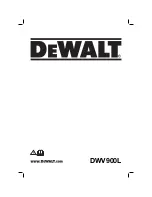
3
•
Maintain charger cord – When unplugging the charger,
pull the plug, not the cord, from the receptacle to reduce
the risk of damage to the electrical plug and cord.
Never carry the charger by its cord or yank it by the cord
to disconnect it from the receptacle. Keep the cord away
from heat, oil and sharp edges. Make sure the cord will not
be stepped on, tripped over or subjected to damage or
stress when the charger is in use. Do not use the charger
with a damaged cord or plug. Replace a damaged charger
immediately.
•
Do not use an extension cord unless it is absolutely
necessary – Using the wrong, damaged or improperly
wired extension cord poses a risk of fire and electric shock.
If an extension cord must be used, plug the charger into a
properly wired 16 gauge or larger extension cord with the
female plug matching the male plug on the charger. Make
sure that the extension cord is in good electrical condition.
•
Use only recommended attachments – Use of an
attachment not recommended or sold by the battery
charger or battery pack manufacturer may result in risk of
fire, electric shock or personal injury.
•
Unplug charger when not in use – Make sure to remove
battery packs from unplugged chargers.
m
WARNING!
To reduce the risk of electric shock,
always unplug the charger before performing any cleaning
or maintenance. Do not allow water to flow into the charger.
Use a Ground Fault Circuit Interrupter (GFCI) to reduce shock
hazards.
•
Do not burn or incinerate battery packs – Battery packs
may explode, causing personal injury or damage.
Toxic fumes and materials are created when battery packs
are burned.
•
Do not crush, drop or damage battery packs – Do not
use the battery pack or charger if they have sustained a
sharp blow, been dropped, run over or have been damaged
in any way (i.e. pierced with a nail, hit with a hammer,
stepped on, etc.).
•
Do not disassemble – Incorrect reassembly may pose
a serious risk of electric shock, fire or exposure to toxic
battery chemicals. If the battery or charger are damaged,
contact an authorized Snow Joe
®
+ Sun Joe
®
dealer or
call the Snow Joe
®
+ Sun Joe
®
customer service center at
1-866-SNOWJOE (1-866-766-9563) for assistance.
•
Battery chemicals cause serious burns – Never let a
damaged battery pack contact the skin, eyes or mouth.
Under abusive conditions, liquid may be ejected from the
battery; avoid contact. Liquid ejected from the battery may
cause irritation or burns. If a damaged battery pack leaks
battery chemicals, use rubber or neoprene gloves to safely
dispose of it. If skin is exposed to battery fluids, wash the
affected area with soap and water and rinse with vinegar.
If eyes are exposed to battery chemicals, immediately
flush with water for 20 minutes and seek medical attention.
Remove and dispose of contaminated clothing.
•
Do not short circuit – A battery pack will short circuit if
a metal object makes a connection between the positive
and negative contacts on the battery pack. Do not place a
battery pack near anything that may cause a short circuit,
such as paperclips, coins, keys, screws, nails and other
metallic objects. A short-circuited battery pack poses a risk
of fire and severe personal injury.
•
Store your battery pack and charger in a cool,
dry place – Do not store the battery pack or charger where
temperatures may exceed 105ºF (40.5ºC), such as in direct
sunlight or inside a vehicle or metal building during the
summer.
Information About the Battery
1. The battery pack supplied with your cordless power tool is
only partially charged. The battery pack has to be charged
completely before you use the tool for the first time.
2.
For optimum battery performance, avoid low discharge
cycles by charging the battery pack frequently.
3. Store the battery pack in a cool place, ideally at
59°F (15°C) and charged fully.
4. Lithium-ion batteries are subject to a natural aging
process. The battery pack must be replaced at the latest
when its capacity falls to just 80% of its capacity when
new. Weakened cells in an aged battery pack are no
longer capable of meeting the high power requirements
needed for the proper operation of your cordless power
scrubber, and therefore pose a safety risk.
5.
Do not throw battery packs into an open fire as this poses
a risk of explosion.
6.
Do not ignite the battery pack or expose it to fire.
7. Do not exhaustively discharge batteries. Exhaustive
discharge will damage the battery cells. The most
common cause of exhaustive discharge is lengthy storage
or non-use of partially discharged batteries. Stop working
as soon as the performance of the battery falls noticeably
or the electronic protection system triggers.
Place the battery pack in storage only after it has been
fully charged.
8. Protect batteries and the tool from overloads.
Overloads will quickly result in overheating and cell
damage inside the battery housing even if this overheating
is not apparent externally.
9. Avoid damage and shocks. Immediately replace batteries
that have been dropped from a height of more than
3 feet (1 meter) or those that have been exposed to violent
shocks, even if the housing of the battery pack appears to
be undamaged. The battery cells inside the battery may
have suffered serious damage. In such instances, please
read the waste disposal information for proper battery
disposal.
10.
If the battery pack suffers overloading and overheating,
the integrated protective cutoff will switch off the
equipment for safety reasons.
IMPORTANT!
Do not press the ON/OFF switch any more
if the protective cut-off has been activated. This may
damage the battery pack.
Summary of Contents for SUNJOE 24V-PWSCRB-CT
Page 14: ...14 NOTES...
Page 16: ...sunjoe com...


































